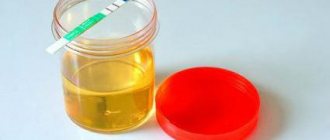Interpretation of urine analysis during pregnancy
When deciphering a pregnant woman’s urine analysis, the following normal indicators are assessed:
- The color depends on the allocated volume of biological fluid and the presence of pigment dyes in it. Normally, urine should be straw-yellow in color due to the content of urochrome.
- The transparency of a liquid characterizes all the properties of the biological components present in it. Normally, urine should be clear.
- Specific gravity indicates the content of dissolved components in urine, such as salts, sugar, urea, etc.
- pH, or acidity, is determined by the concentrated content of hydrogen ions formed in a liquid as a result of the dissociation of organic and inorganic acids.
- Protein should not normally be detected in the urine of a pregnant woman, and if urine analysis shows its presence, we are talking about proteinuria, which can be physiological (against the background of severe mental shock, physical activity, eating large amounts of protein) and pathological (diseases of the genitourinary system or allergy).
- Sugar is not normally detected, but if glucose is detected in a pregnant woman’s urine test, suspicions of diabetes mellitus arise, and the woman is advised to have an additional blood test for sugar.
- Bilirubin should not be detected in the urine. If it is detected, we can talk about jaundice, hepatitis and other pathologies that interfere with the outflow of bile. The urine will be the color of dark beer.
- Ketone bodies are not normally detected; a urine test with the presence of acetone during pregnancy can show early toxicosis, anemia and gestational diabetes mellitus.
- Nitrites are normally absent; their detection in the urine of pregnant women indicates the presence of inflammation in the organs of the urinary tract.
- Hemoglobin detected in urine is a clear indicator of pathology, which indicates anemia.
- Red blood cells are normally detected singly (1-2 per field of view). If there are more of them, we are talking about hematuria associated with infections of the renal system and urinary tract.
- Leukocytes in a urine test in a pregnant woman should not exceed 0-5 in the field of view, otherwise we are talking about an inflammatory process in the kidneys - glomerulonephritis and pyelonephritis, as well as diseases of the urinary system - cystitis.
- Epithelial cells in urine should not exceed 0-3 values in the field of view. If their number exceeds this value, most likely we are talking about kidney diseases - pyelonephritis, urolithiasis.
- Cylinders are absent in the urine of a healthy person; their presence in a urine test during pregnancy indicates various kidney diseases.
- Bacteria and fungi detected in urine indicate infectious diseases of the genitourinary system, for example, urethritis, vaginal thrush, etc.
- Salts indicate a change in urine pH reaction. Normally, urine contains oxalates and urates in single quantities. Excess salts indicate the development of urolithiasis.
- Normally, mucus can be detected in a small amount in a pregnant woman’s analysis. Its presence in large quantities indicates inflammatory diseases of the genitourinary system.
Laboratory tests of urine during pregnancy
A urine test during gestation is prescribed to prevent deterioration of well-being and the development of hidden pathological processes. High-quality diagnostics, carried out in any institution or network of Invitro laboratories, allows you to promptly identify and eliminate the symptoms of an incipient disease.
During the period of gestation, a woman’s urinary system begins to function more intensively, trying to evacuate metabolic products not only from the mother, but also from the child in the womb. In the early stages, due to an increase in the speed of blood flow, the organs receive it in a larger volume than usual. As a result, glomerular filtration increases, while tubular reabsorption remains at the same level. This leads to the development of swelling.
Simultaneously with the increase in pregnancy and fetal growth, the uterus increases in size. It compresses neighboring organs, impairing their functioning, causing them to strive to change their location. The bladder moves upward, leaving the pelvic area; in some cases, a hydroureter develops, in which the lumen of the excretory tract expands. This becomes a favorable circumstance for the penetration of various kinds of infections along the ascending path into the bladder and further into the kidneys.
Purpose of appointment and frequency of administration
Urine examination is an important prognostic parameter for the condition of the kidneys and the entire urinary system. It does not require effort on the part of the expectant mother, but provides valuable information for the doctor, allowing you to adjust pregnancy management tactics.
Advice! Urinalysis makes it possible to promptly detect inflammatory diseases such as cystitis, pyelonephritis, as well as some dangerous conditions - gestosis, diabetes mellitus, preeclampsia.
Changes in the levels of protein, glucose, and leukocytes may indicate the presence of pathologies that are not always caused by impaired renal function. During the gestation period, the urinary organs react to changes in the functioning of the immune, cardiovascular, and endocrine systems. This is why laboratory testing is often carried out for monitoring purposes. In most cases, pregnant women are prescribed a general urine test. It pursues the following goals:
- dynamic monitoring of the pregnant woman’s well-being;
- early diagnosis of pathologies of the urinary system and other internal organs;
- monitoring the course of the identified disease;
- assessment of the effectiveness of the chosen therapy.
The frequency of clinical analysis is:
| Term/ trimester | Frequency, once/week |
| First | 1 x 4 |
| Second and third (beginning) | 1 x 2 |
| From 35 weeks | weekly |
The state of urine as an important diagnostic sign
Considering the data indicated in the table, the woman actually has to get tested at every scheduled visit to the gynecologist.
Urine is an ultrafiltrate of blood plasma, a human waste product, and is an aqueous solution of electrolytes and organic substances. Its composition is quite complex and includes many components of various origins, which should normally be excreted from the body.
One of the main functions of the kidneys is to filter blood plasma and cleanse it of substances unnecessary for the body - ballast. The method of their penetration into urine is different - some are secreted through the glomerular apparatus, others are secreted through the renal tubules. All these elements enter the liquid, forming primary urine. During the process of reabsorption (reabsorption), they re-enter the blood, after which a secondary product is formed. It is excreted by the kidneys into the bladder, and then out through the urethral canal.
Types of analyzes and their characteristics
The study of urine during pregnancy can be performed using various methods. First of all, to confirm conception, it is recommended to conduct a pregnancy test - a urine test at home. In medical practice, there are a number of tests; the selection of the most informative in each specific situation is made by the doctor. General clinical analysis is routine. It is considered a screening test, and if unsatisfactory results are obtained, the doctor prescribes a more detailed extended diagnosis. This includes a biochemical study that allows one to detect the concentration of complex compounds, as well as various tests that make it possible to determine pathological changes occurring in the body.
General clinical urine analysis
It is the most informative and popular type of urine test in medical practice. Prescribed to all pregnant women from the moment of registration at the antenatal clinic. It involves a thorough study of organoleptic, physicochemical, biological properties, as well as microscopic examination of the sediment. If the values of the main indicators correspond to the norm, then the pregnancy proceeds normally, and there are no deviations in the functioning of organs and systems.
Urinalysis according to Nechiporenko
This type of study is carried out to identify infectious lesions of the genitourinary system, to check the functional capacity of the kidneys, urethra, and bladder during pregnancy. It allows you to determine the number of formed elements in 1 ml, taken per unit volume. The following values are considered normal:
- leukocytes – up to 2000;
- red blood cells – up to 1000;
- cylinders - up to 20.
Attention! The Nechiporenko test is prescribed during monitoring of gestation, in case of unsatisfactory results after OAM. The purpose of the analysis is to give a more complete clinical picture of the changes occurring in the body of the expectant mother.
Zimnitsky test
The purpose of diagnosis is to assess the concentration and throughput function of the kidneys. The study reveals daily diuresis, that is, how many liters of fluid can pass through a paired organ in 24 hours, as well as how the dilution function is performed (if secondary urine contains a large number of components useful for the body, it is considered unsatisfactory).
Urine collection is carried out throughout the day according to a special scheme: one portion of liquid is placed in each container (6-8 in total). The interval between receiving them is on average 3-4 hours.
Rehberg's test
It is carried out to assess the reabsorption and excretory function of the kidneys and glomerular filtration rate. The indicator is the renal clearance of endogenous creatinine. This type of analysis is indicated when it comes to nephritis, renal failure, “shrinked kidney” syndrome, glomerulonephritis.
The material should be collected throughout the day, noting the number of acts of urination and the volume of urine released at a time. The biological material prepared in this way must be mixed and poured into a 50-70 ml container.
LHC urine culture
During a general clinical analysis, the laboratory technician is required to conduct a microscopic examination of the sediment. If fungi or other microorganisms are detected in it in concentrations exceeding normal values, the development of bacteriuria is indicated, and a more in-depth study of the condition is carried out, determining the type of microorganisms. During the gestation period, this analysis is indicated twice: at 9-12 and 35-36 weeks. If an infection is detected, the examination is carried out more often. Material for culture should be collected using a catheter. To avoid pain, it must be inserted by a nurse.
Important indicators and their normal values
When a urine test is performed during pregnancy, expectant mothers are interested in what it shows. Women want to get a transcript and find out if there are any abnormalities in the functioning of the internal organs. It should be understood that only a doctor can provide a qualified opinion, while the patient can only approximately interpret possible deviations, relying on reliable sources of information.
| Indicators | Norm |
| Physico-chemical | |
| Quantity | Not less than 50 ml |
| Color | Light yellow or straw |
| Transparency | Transparent |
| Relative density (specific gravity) | 1,010-1,025 |
| Reaction (pH) | 5-7 |
| Protein | Not higher than 0.033 g/l or not determined |
| Glucose | None |
| Ketone bodies | |
| Bile acids | |
| Bilirubin | |
| Microscopic | |
| Red blood cells | 0-1 in sight |
| Leukocytes | 6-8 in sight |
| Cylinders: • waxy; • hyaline; • granular; • leukocytes; • epithelial; • erythrocyte. | None |
| Epithelium: • transitional; • flat; • renal. | Single in sight |
| Slime | In small quantities |
| Salts | None |
| Bacteria | |
Mandatory parameters for urine analysis during pregnancy are considered to be the normal values indicated in the table. These are available in various reference materials. These data are typical for a healthy girl or woman before conception.
The results of the analysis during the gestation period should also not differ from the norm. Despite the excessive stress that the excretory system experiences during pregnancy, compensatory functions smooth out these changes without going beyond physiology. The appearance of any, even minor, deviations indicates hidden or obvious pathologies. You need to know a little more about them, even in general terms.
The most common deviations and their causes
The most important step in making a correct diagnosis based on a urine test in pregnant women is considered to be a competent decoding of indicators and determination of the norm. The effectiveness of the prescribed treatment and the adequate choice of medications depend on a clear and reliable identification of the cause of existing deviations. To gain an in-depth understanding of the processes occurring in a pregnant woman’s body, it is not enough to know about normal indicators. It is important to have an idea about the main pathological changes that can await a woman during pregnancy. These include:
- changes in color and density;
- decreased transparency;
- proteinuria – high protein;
- glucose;
- presence of erythrocytes and leukocytes;
- bacteriuria.
The intensity of the deviations depends on the type of pathology and the degree of its severity, and here we are talking not only about disorders of the genitourinary area, but also diseases of other organs.
Amount of urine. In medicine, it is called diuresis and refers to the volume of urine excreted in a certain unit of time - day, night, day. In normal conditions, it makes up 70-80% of the liquid drunk with a consumption rate of 1.5-2 liters. In a pregnant woman, this parameter increases by a quarter, which is due to the intensive functioning of the kidneys.
Color. Light, transparent urine indicates a low concentration of substances and is typical for diabetes of any type. On the contrary, brightly colored urine is released when there is intense loss of fluid from the body (fever, vomiting, diarrhea). A reddish-brown tint indicates possible kidney injuries and tumor processes.
Transparency. Turbid urine indicates inflammatory diseases of the genitourinary tract or changes in protein, fat, mucus, salts, red blood cells or bacteria. To clarify the cause, additional studies are performed.
Density. High levels indicate dehydration, which can develop as a result of conditions such as diabetes mellitus, toxicosis or glomerulonephritis. Hypersthenuria is observed in kidney pathologies and preeclampsia.
Urine reaction. A low reading indicates the presence of fever, tuberculosis or diabetes. High values are observed in inflammatory diseases.
Protein. An increased amount is typical for infectious lesions of the genitourinary system, severe toxicosis, preeclamptic syndrome, and renal pathologies.
Glucose. During pregnancy, the level of the substance fluctuates in the range of 3.2-5.4 mmol/l. values below or above the specified threshold indicate hypo or hyperglycemia. In later stages, such deviations indicate the appearance of gestational diabetes.
Bilirubin. If it is present in urine in any quantity, you should pay attention to the liver, since problems with this organ provoke the release of urobilin.
Ketone bodies. In addition to glucose, acetone is considered a characteristic indicator of the likelihood of developing diabetes. Normally, they should not be present in a pregnant woman.
Red blood cells and leukocytes. If they are detected, doctors suspect the presence of internal bleeding or severe inflammation. During the gestation period, the presence of 1-2 units in the field of view is considered normal.
Epithelium. The acceptable value for the presence of the internal lining of the body cavity in urine is 0-3 cells. Exceeding this indicator indicates inflammation of various etiologies.
Salt. Phosphates, urates or oxalates may be detected in the urine of a pregnant woman. Regardless of the type, they are a sign of metabolic disorders or nutritional errors.
Normal indicators of general clinical analysis
Below are characteristics and numbers that are typical for tests of healthy women.
| Indicators | Meaning |
| Amount of urine | 150-250 ml |
| Color | Straw yellow, amber yellow |
| Transparency | Full |
| Density | 1,010-1,030 |
| pH | 5,0-7,0 |
| Protein | Up to 0.033 g/l |
| Glucose | Absent |
| Bilirubin | Absent |
| Urobilinogen | Footprints |
| Ketone bodies | None |
| Red blood cells | 1-2 in point of view |
| Leukocytes | Up to 5 in p.z. |
| Epithelium | Single cells of squamous and transitional epithelium |
| Cylinders | Single hyaline casts |
| Salts | Single urates and oxalates |
Purpose of the study
During the period of bearing a child, the kidneys have a double load - they remove waste products not only from the woman herself, but also from the fetus. The enlarging uterus compresses the visceral organs (located in the abdominal cavity), this condition can cause stagnation of urine, swelling of the renal parenchyma and an ascending inflammatory process that develops as a result of infection of the bladder.
The immune system of the expectant mother is weakened; due to changes in the woman’s hormonal levels, the ureters relax, which provokes infection into the kidneys or exacerbation of chronic diseases of the urinary system.
The condition and general tone of the contractile activity of the urinary tract during pregnancy depends not only on hormonal levels, but also on inorganic and organic substances
Using a urine test in pregnant women, it is possible to identify such a pathological complication as gestosis - a life-threatening condition for both the expectant mother and the baby, which is manifested by edema, increased blood pressure, convulsions and loss of protein by the body.
Urine examination during early pregnancy is prescribed by practicing obstetricians-gynecologists:
- for timely diagnosis of various pathological processes in the urinary system and other internal organs;
- monitoring the course of the detected disease and assessing the rationality of the course of medical therapy.
Deciphering a urine test during pregnancy plays an important role in the dynamic monitoring of the health of the female body. Urine examination is recommended to be carried out according to the following algorithm:
- in the first trimester – once every 4 weeks;
- in II and III – once every 2 weeks;
- starting from the 35th week - once every 7 days.
Urinalysis according to Nicheporenko
If the expectant mother experiences swelling, pain in the lower back and lower abdomen, it is necessary to exclude infectious and inflammatory processes. For this purpose, during pregnancy, a urine test according to Nechiporenko is prescribed, which will show the presence or absence of pathologies.
When conducting this urine test in pregnant women, two indicators are taken into account - the norm of leukocytes and erythrocytes in 1 ml of biological fluid. For leukocytes it is 2000 in 1 ml, for red blood cells - 1000. If the result is higher than normal, most likely we are talking about infection of the bladder, urethra and kidneys.
If the number of leukocytes is exceeded, this may indicate pyelonephritis - inflammation of the kidneys. If the indicators are slightly increased, we may be talking about errors that the woman made during urine collection. In order not to worry once again about what a urine test shows during an existing pregnancy and how correct these results will be, biological fluid for research should be collected correctly. This will be discussed below.
Possible deviations from the norm
According to a urine test, deviations from the norms of the following indicators are determined:
- The color of the liquid can vary from yellowish to amber. The change indicates the following pathologies: darkening: water imbalance, cirrhotic changes, suprahepatic jaundice;
- red: eating red foods (such as beets), kidney inflammation or developing urolithiasis;
- green: liver dysfunction;
- whitish: lymphostasis or salt discharge.
Is it possible to determine on your own that urine does not indicate problems?
You can determine the signs of “good” urine using your own observations if you pay attention to the following factors:
- Color of collected urine . Normally, its shade should vary from straw yellow to amber yellow. The color can be enhanced by taking multivitamin medications prescribed to expectant mothers. However, the shade should in no case be dark.
- Smell . It may not exist at all, or it may not be pronounced. No strong aromas. If you feel some acidity and the smell is intrusive, you should inform your doctor.
- Transparency . Urine should be clear, there can be no talk of any cloudy impurities. If the collected liquid is cloudy, that is, it is impossible to see anything else through the container, most likely there are bacteria and epithelium in large quantities in the urine, which is not a good sign.
Possible complications
Adverse consequences depend on what kind of pathology we are talking about. A urine test is a test that provides general information. To avoid confusion, it must be interpreted depending on the patient’s condition, the results of other tests, and specific complaints. Therefore, we will analyze only those cases that have already been discussed in the previous paragraph.
So, the inflammatory process - both in the urinary tract and systemic - can threaten with such consequences as:
- Spread (from the initially affected area to nearby areas).
- Worsening (up to sepsis, if there is a bacterial infection).
- Chronization (that is, the occurrence of a constantly existing unfavorable focus).
Severe inflammation adversely affects the condition of the expectant mother and child; there is a high risk of infection of the fetus during pregnancy or childbirth.
Gestational diabetes can lead to:
- severe metabolic disorders;
- a sharp worsening of the severity of the condition;
- to whom.
Of course, in such a situation, not only the expectant mother will suffer, but also the child - growth and development delays, and oxygen deficiency are likely.
Preeclampsia is dangerous due to the possible consequences:
- Delayed growth and development of the child.
- Chronic hypoxia (oxygen starvation) of the fetus.
- Premature birth.
It can lead to an attack of seizures - eclampsia. This is an emergency condition that requires qualified medical care to avoid the death of the woman and child.
Intoxications have different effects; a mild degree may not be detected objectively (that is, there are no complaints), and only deviations from the norm are observed in the analysis. In case of severe poisoning, hypoxia, impaired growth and development of the fetus, and termination of pregnancy are possible.
Urine culture test
Pregnant women undergo a variety of urine tests, and bacterial culture tests are also included in this number. What is it for? Using this analysis, you can determine the bacteria that are in a woman’s body. That is, the biological fluid of a pregnant woman is used as a nutrient medium for growing pathogenic microflora in it.
If a woman is sick, a urine test will show not only the presence of bacteria, but also their sensitivity to certain medications, which is important during pregnancy. As a result, the doctor will be able to prescribe the most gentle treatment that is safe for the mother and unborn child.
During pregnancy, for bacterial culture, urine analysis is usually collected with a catheter, then the resulting liquid is taken to the laboratory and placed in a nutrient medium. After this, urine, saturated with pathogenic microorganisms, is placed in different test tubes and placed in a heating cabinet, where favorable conditions are created for the growth and reproduction of bacteria.
At the end of the study, approximately on days 5-10, the doctor finds out exactly what microflora was in the woman’s urine. If necessary, she is prescribed treatment.
Basic indicators
What should be the protein and leukocytes in urine during pregnancy? What do key indicators mean? Deciphering this data will allow you to soberly assess the situation and not panic ahead of time.
Leukocyturia
An increased number of leukocytes is an important indicator indicating an inflammatory process in the genitourinary system. Every day the baby's weight increases, increasing pressure on the mother's internal organs. This provokes a disruption of the normal outflow of urine, which is fraught with stagnation and the proliferation of pathogenic bacteria. Exceeding the normal level of leukocyte count (1-5 units per field of view) is an indication for more extensive examinations. If necessary, the doctor may prescribe antimicrobial drugs.
Leukocytes in urine
Elevated leukocytes pose a threat to the health of not only the expectant mother, but also the baby. To identify pathological processes, a woman must undergo a bacteriological urine test and bacterial culture for the presence of a nutrient medium for microbes. This will help determine and prescribe adequate therapy to suppress the source of infection.
Proteinuria
This term refers to the presence of protein in the urine. This indicator is one of the most important during pregnancy.
Normally, protein should be completely absent from urine, but during pregnancy a small amount of it is allowed, up to 0.033 g/l. This is explained by the increased load on the kidneys, which are forced to work for two at once. If the amount of protein significantly exceeds the permissible limit in any trimester, this may indicate a number of pathological processes. First of all, the doctor must exclude the condition of preeclampsia, which is characterized by a significant increase in blood pressure and an excess of the normal amount of protein.
Detection of proteinuria in urine
Preeclampsia is a dangerous pathology, most often diagnosed in the second trimester. To detect the condition in a timely manner and prevent its development, the expectant mother is forced to test urine twice a month, starting from the 12th week of pregnancy. Undiagnosed preeclampsia can lead to seizures and bleeding in the brain due to high blood pressure. This process disrupts the functioning of the placenta, which can lead to various unpleasant consequences, including the death of the fetus from hypoxia.
Preeclampsia
Preeclampsia is diagnosed by the presence of protein and healin casts in the urine. The normal number of cylinders is 1-2 in the field of view. With gestosis, this number increases sharply.
Gestosis is accompanied by symptoms such as high blood pressure and swelling. The lack of timely treatment entails cerebral edema and the death of the woman along with the fetus.
Exceeding the normal amount of protein in the urine in pregnant women is a dangerous symptom
Exceeding the normal amount of protein in the urine in pregnant women is a dangerous symptom that requires immediate intervention from a qualified specialist.
Bilirubin
Bilirubin is a bile pigment that is not normally found in urine. The appearance of this element in the urine may indicate jaundice or hepatitis. But it also happens that bilirubin appears due to increased pressure of the uterus on the gallbladder in the last stages of pregnancy. In any case, this indicator should be kept under control by regularly submitting biomaterial for research.
Glucosuria
This is the name for the appearance of glucose in the urine, which should normally be absent. Although sugar may appear in urine during pregnancy, you need to pay close attention to your health and make sure that you do not have diabetes. If the amount of glucose during a repeated test is the same or higher than in the previous one, the doctor will prescribe a daily urine test for glucose.
Ideally, there is no glucose in urine, but in the second and third trimester a doctor can detect the presence of sugar in a pregnant woman.
Hematuria
The presence of red blood cells in urine may indicate that some disease is occurring in the expectant mother’s body. A healthy person does not have red blood cells in the urine. If they were detected in a pregnant woman, it is necessary to find out what causes provoked the identified indicators.
Red blood cells may appear due to phenomena such as:
- Inflammatory process in the genitourinary system.
- Exacerbations of urolithiasis. In this case, sand and stones injure the mucous membrane of the walls of the urinary system, which causes blood to enter the urine and, consequently, the appearance of red blood cells in the analysis.
- Violation of the technique for collecting biomaterial, in which bloody discharge from the vagina, which is sometimes normal during pregnancy, can get into the container.
The presence of red blood cells in urine may indicate an exacerbation of urolithiasis
Hematuria in a pregnant woman can indicate a number of diseases. To clarify the content of blood elements in urine, the doctor prescribes tests according to the Nechiporenko system.
Salts and mucus
If the urine contains salts of different types, this may indicate a metabolic disorder, which is an inevitable companion of a pregnant woman. Exceeding the normal amount of salt may also indicate an incorrect diet of the expectant mother, which needs to be brought back to normal. Salts in urine can cause the formation of stones and sand, which will lead to attacks of renal colic.
The presence of mucus in the urine may indicate inflammatory processes occurring in the mucous membranes of the genitourinary system. Also, mucus may appear due to violation of intimate hygiene rules during urine collection for analysis. For this reason, before collecting urine for analysis, you should first perform thorough genital hygiene.
A general urine test during pregnancy is an important and informative type of diagnosis for assessing a woman’s condition, which helps the doctor determine the presence of a particular pathology and the reasons that provoked it. Regular and timely submission of biomaterial for research will help control the normal course of pregnancy, identifying dangerous pathologies at the earliest stages of their occurrence.
If your urine test is bad
A poor urine test in pregnant women may indicate asymptomatic bacteriuria, early and late toxicosis, pyelonephritis, cystitis and other pathological conditions that threaten the normal course of pregnancy. Depending on what the study shows - proteinuria, hematuria, etc., the woman is recommended to undergo additional examination (Nechiporenko analysis, ultrasound, etc.).
If a poor urine test is detected late in pregnancy, and this is accompanied by increasing edema and arterial hypertension, we may be talking about gestosis. This condition is dangerous for the mother and fetus. The woman is urgently hospitalized in the hospital. Read more about gestosis →
If a urine test during pregnancy shows poor results, and the woman complains of fever, lower back pain and weakness, most likely we are talking about a kidney infection. This condition is also treated in an inpatient setting.
What to do if your urine test turns out to be bad during pregnancy? There is no need to worry, it is important to follow all the doctor’s recommendations and not refuse additional diagnostic methods and inpatient treatment.
How to treat?
If negative results are obtained before starting treatment, the doctor prescribes a re-examination and urine tests:
- according to Nechiporenko to clarify the number of leukocytes, erythrocytes and cylinders;
- according to Zimnitsky to determine the density of urine, its quantity and the overall performance of the kidneys;
- daily proteinuria to detect protein in urine.
Only based on the results of these tests can a consultation with a nephrologist, urologist or other doctor be recommended to confirm the preliminary diagnosis.
Further therapeutic actions depend entirely on the detected pathology, and for a pregnant patient may include:
- taking narrow-acting drugs that have a gentle effect on the weakened female body and the gestating fetus, and are selected depending on test results, week of pregnancy, etc.;
- regular monitoring of blood pressure, tracking its dynamics and recording the obtained indicators;
- decongestant measures with changing the drinking regime, limiting salty foods;
- increasing activity through daily walks and visiting parks;
- reducing the consumption of fried, sweet, sour foods, etc.
If necessary, therapy can be carried out in a hospital setting to eliminate possible risks of pregnancy complications.
Physiological changes in the urinary system during pregnancy
During pregnancy, the expectant mother's kidneys work more intensively, since they are faced with the task of evacuating from the body not only the products of their metabolic processes, but also the metabolic products of the fetus. Many women ask whether a urine test shows pregnancy. Unfortunately, it is impossible to determine the presence of pregnancy using a general urine test; there are other methods for this, such as the hCG test.
In the first 12 weeks of pregnancy, blood flow increases, and therefore all organs begin to receive a larger volume of circulating blood. Filtration of the glomeruli increases, and reabsorption of the tubules does not change throughout pregnancy, which causes the development of edema and fluid retention in the body.
As the uterus enlarges, the position of the internal organs changes. During the third trimester, the bladder moves upward outside the pelvis and its walls thicken to withstand increased pressure from the uterus. In rare cases, hydroureter occurs - a violation of the patency of the ureter, usually the right one. This is explained by its compression at the level of the pelvic bone.
Under the influence of progesterone, the tone of the urinary tract decreases, they expand, as a result of which the infection more easily penetrates the bladder with the subsequent development of pyelonephritis.
What do bad blood tests indicate during pregnancy?
When studying a blood test, the doctor, first of all, pays attention to the level of hemoglobin, leukocytes and platelets.
- Hemoglobin in a pregnant woman has a lower limit of 110 g/l. Ideally, the coefficient of this indicator should be 120-140 g/l. A decrease in its level indicates the development of anemia, which can lead to oxygen starvation of the fetus and, as a consequence, a delay in its development.
- Leukocytes are one of the important indicators in a blood test. The upper limit of leukocytes reaches 9 units, the lower – 4 units. Exceeding the upper limit indicates the development of infection in the body. A slight increase in leukocytes in the second half of pregnancy is not considered a pathology.
- Platelets – their number should not fall below 150 thousand/µl. When the level is low, a pregnant woman has poor blood clotting, which can lead to bleeding during childbirth. An increase in platelets (more than 400 thousand/μl) can lead to the formation of venous and arterial thrombosis. This often leads to spontaneous miscarriages.
Poor tests during pregnancy are those that have significant deviations from the following indicators:
- Color index – 0.86-1.1;
- Hemoglobin – 120-140 g/l;
- ESR – 2-15 mm/h;
- Red blood cells – (3.9-4.7)x1012 cells/l;
- Leukocytes – (4.0-9.0)x109 l, in the second and third trimester the level can increase to 11 units;
- Platelets – 150-390 thousand/µl;
- Band neutrophils – 1-6%;
- Segmented neutrophils – 47-72%;
- Metamyelocytes – 0%;
- Myelocytes – 0%;
- Eosinophils – 0.5-5%.
Having studied your blood test and discovered deviations from the norm, do not rush to draw conclusions on your own. Only a doctor should make a conclusion about how bad the pregnancy tests actually are.
How to properly collect urine for analysis during pregnancy
A gynecologist or midwife should tell pregnant women how to properly take a urine test when registering, and only some women know about this before becoming pregnant.
Preparation for the collection of biological fluid is based not only on the observance of careful hygiene measures, but also on separate recommendations for women:
- Approximately a day before taking a urine test, it is not advisable for the expectant mother to subject her body to physical and psycho-emotional stress, as this can lead to the appearance of protein in the urine. Also during this time, it is important to avoid eating spicy, salty and meat dishes. Compliance with these recommendations will allow you to obtain the correct information when interpreting a general urine test in pregnant women.
- Often, a poor urine test obtained by a pregnant woman is the result of a carelessly selected container for collecting biological fluid. Currently, a sterile and compact jar for collecting analysis can be purchased at a pharmacy.
- Urine for analysis during pregnancy should be collected in the morning, immediately after waking up. In this case, the density of the collected biological fluid will be more concentrated, so any deviations from the norm will be obvious.
- Many pregnant women who are about to have a general urinalysis test are interested in: how much to put in a jar so that the result turns out to be normal? Experts advise filling the container up to half.
How else to take a urine test during pregnancy: it is not recommended to shake and agitate the sample, or filter the urine through gauze (some pregnant women do this in the hope of getting a good test result); the collected sample must be delivered to the laboratory within the next hour - only if all these conditions are met. the result will be as correct and correct as possible.
During pregnancy, every woman should know how to take a general and daily urine test. This is important to protect yourself and your unborn baby from health problems. Compliance with nutritional rules on the eve of collecting biomaterial and the use of a sterile container are some of the conditions for correctly assessing the result. With a responsible approach, a woman’s pregnancy will end safely, and the birth itself will take place without complications. Urinalysis during pregnancy is an important aspect to ensure its normal course.
Author: Olga Rogozhkina, doctor, especially for Mama66.ru
How to properly collect material for analysis
For general analysis, urine is collected in the morning. This portion will show the most reliable result, since it is concentrated. Before urinating, you need to toilet the external genitalia, and block the entrance to the vagina with a cotton swab. This is necessary so that foreign flora, mucus, and secretions do not get into the sample.
At the beginning of urination, a small amount of liquid should be flushed down the toilet, and the rest should be collected in a clean container. Half a jar is enough. The material should be delivered to the laboratory within 2 hours.
You cannot: shake the container, strain urine, collect it in advance (for example, in the evening), place it on a hot radiator. Such actions distort the results of the study.
For the Zimnitsky test, urine is collected differently. Collection is made within 24 hours. You need to prepare 8 jars - they should be larger in volume compared to containers for general urine analysis. Determine time intervals: for example, 6 - 9 hours, 9 - 12 hours and so on. The first portion of urine after waking up is poured into the toilet, then they begin to collect the material. So, in the first jar you need to collect all the urine that is released between 6 and 9 hours, and so on throughout the day. The next day at 6 am she finishes collecting and the jars are taken to the laboratory.
For bacteriological culture, the material is collected using a catheter so that flora from the mucous membrane of the genital tract does not get into the jar.











